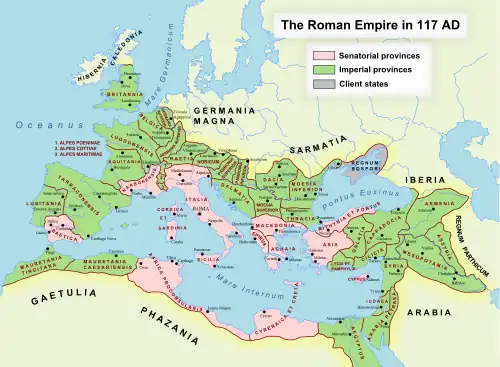| Millennium: | 1st millennium |
|---|---|
| Centuries: | |
| Decades: | |
| Years: |
| AD 117 by topic |
|---|
| Leaders |
| Categories |
|
| Gregorian calendar | 117 CXVII |
| Ab urbe condita | 870 |
| Assyrian calendar | 4867 |
| Balinese saka calendar | 38–39 |
| Bengali calendar | −476 |
| Berber calendar | 1067 |
| Buddhist calendar | 661 |
| Burmese calendar | −521 |
| Byzantine calendar | 5625–5626 |
| Chinese calendar | 丙辰年 (Fire Dragon) 2814 or 2607 — to — 丁巳年 (Fire Snake) 2815 or 2608 |
| Coptic calendar | −167 – −166 |
| Discordian calendar | 1283 |
| Ethiopian calendar | 109–110 |
| Hebrew calendar | 3877–3878 |
| Hindu calendars | |
| - Vikram Samvat | 173–174 |
| - Shaka Samvat | 38–39 |
| - Kali Yuga | 3217–3218 |
| Holocene calendar | 10117 |
| Iranian calendar | 505 BP – 504 BP |
| Islamic calendar | 521 BH – 520 BH |
| Javanese calendar | N/A |
| Julian calendar | 117 CXVII |
| Korean calendar | 2450 |
| Minguo calendar | 1795 before ROC 民前1795年 |
| Nanakshahi calendar | −1351 |
| Seleucid era | 428/429 AG |
| Thai solar calendar | 659–660 |
| Tibetan calendar | 阳火龙年 (male Fire-Dragon) 243 or −138 or −910 — to — 阴火蛇年 (female Fire-Snake) 244 or −137 or −909 |

The Roman Empire reaches its maximal extent between 116 and 117
Year 117 (CXVII) was a common year starting on Thursday (link will display the full calendar) of the Julian calendar. At the time, it was known as the Year of the Consulship of Niger and Apronianus (or, less frequently, year 870 Ab urbe condita). The denomination 117 for this year has been used since the early medieval period, when the Anno Domini calendar era became the prevalent method in Europe for naming years.
Events
By place
Roman Empire
- Trajan subdues a Jewish revolt (the Kitos War), then falls seriously ill, leaving Hadrian in command of the east.
- On his death bed, Trajan allegedly adopts Hadrian and designates him as his successor.
- August 9 - 11 – Emperor Trajan dies of a stroke at Selinus in Cilicia, age 63, while en route from Mesopotamia to Italy, leaving the Roman Empire at its maximal territorial extent.
- Hadrian, who will reign until 138, succeeds him.
- Hadrian, a Spaniard like Trajan, as Emperor inaugurates a policy of retrenchment and cultural integration, giving up the policy of conquest of his predecessor in order to consolidate the empire.
- Hadrian returns large parts of Mesopotamia to the Parthians, as part of a peace settlement.
- Construction begins on the Pantheon in Rome.
- The Roman Empire reaches its greatest extent.
By topic
Commerce
Religion
- John I becomes the 7th Bishop of Jerusalem.
Births
- Aelius Aristides, Greek orator (d. 181)[1]
Deaths
- August 8 – Trajan, Roman emperor (b. AD 53)
- Gaius Cornelius Tacitus, Roman historian (b. AD 56)
- Gaius Julius Quadratus Bassus, Roman general in Judea (b. AD 70)
- Hermione of Ephesus, Maurus, Pantalemon and Sergius, Astius and several other Christian martyrs in persecution by Trajan
References
- ↑ Wee, John Z. (2017). The Comparable Body - Analogy and Metaphor in Ancient Mesopotamian, Egyptian, and Greco-Roman Medicine. BRILL. p. 247. ISBN 9789004356771.
This article is issued from Wikipedia. The text is licensed under Creative Commons - Attribution - Sharealike. Additional terms may apply for the media files.